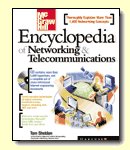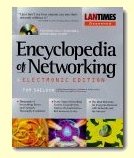|
Site home page
(news and notices)
Get alerts when Linktionary
is updated
Book updates and addendums

Get info about the Encyclopedia of Networking
and Telecommunicatons, 3rd edition (2001)

Download the electronic version of the Encyclopedia
of Networking, 2nd edition (1996). It's free!
Contribute to this site
Electronic licensing info
|
|
G Series ITU Recommendations
Related Entries Web Links New/Updated Information
Note: Many topics at this site are reduced versions of the text in "The Encyclopedia of Networking and Telecommunications." Search results will not be as extensive as a search of the book's CD-ROM.
The G Series of ITU recommendations are referred to as "Transmission systems and media, digital systems and networks." Most of the recommendations below G.600 are related to analog telephone equipment and circuits. The G.600 series is related to transmission media (twisted- pair, coaxial, and fiber-optic cable) for the telephone system. The G.700 series recommendations are related to digital transmission systems, in particular, coding of analog signals into digital signals. These standards are listed below.
- G.601 and G.602 Cable general characteristics
- G.611 through G.614 Symmetric cable pairs
- G.621 through G.623 Land coaxial cable
- G.631 Submarine cables
- G.650 through G.655 Optical fiber cable
- G.661 through G.692 Characteristics of optical components and subsystems
- G.701 through G.707 Digital transmission systems vocabulary, bit-rate hierarchy, physical/electrical characteristics, synchronous frame structures, and other
- G.711 and G.712 PCM (pulse code modulation) of voice frequencies and transmission performance characteristics of PCM channels
- G.720 through G.729 Coding of speech, silence compression schemes, channel coding for wireless, ADPCM (Adaptive Differential Pulse Code Modulation)
- G.731 through G.755 Characteristics of multiplexing equipment
- G.761 through G.767 Principal characteristics of transcoder and digital multiplication equipment
- G.772 through G.776 Operations, administration, and maintenance features of transmission equipment
- G.780 through G.785 Principal characteristics of multiplexing equipment for the synchronous digital hierarchy
- G.801 through G.842 General aspects and design objectives of digital networks, internetworking, architectures of transport networks, timing characteristics, error and jitter controls
- G.851 through G.855 Management of transport networks
- G.872 Architecture of optical transport networks
- G.901 through G.958 Digital line systems, parameters of optical fiber cable systems, FDM (frequency division multiplexing) systems
- G.960 through G.967 ISDN access systems
- G.971 through G.976 Optical fiber submarine cable systems
- G.981 through G.983 Optical line systems for local and access networks
- G.991.1 High-bit-rate digital subscriber line (HDSL) transceivers
In particular, the G.711, G.723, G.726, G.728, and G.729 voice-coding techniques are the most important for multimedia networking. These techniques improve bandwidth, voice quality and other factors. G.723.1 defines a technique for compressing speech or audio at very low rates (5.3 and 6.3 Kbits/sec). The techniques are components of the IMTC (International Multimedia Teleconferencing Consortium) standard for Internet telephony. See "Compression Techniques" for more information, as well as "Voice over IP (VoIP)" and "Multimedia."
Copyright (c) 2001 Tom Sheldon and Big Sur Multimedia.
All rights reserved under Pan American and International copyright conventions.

|

